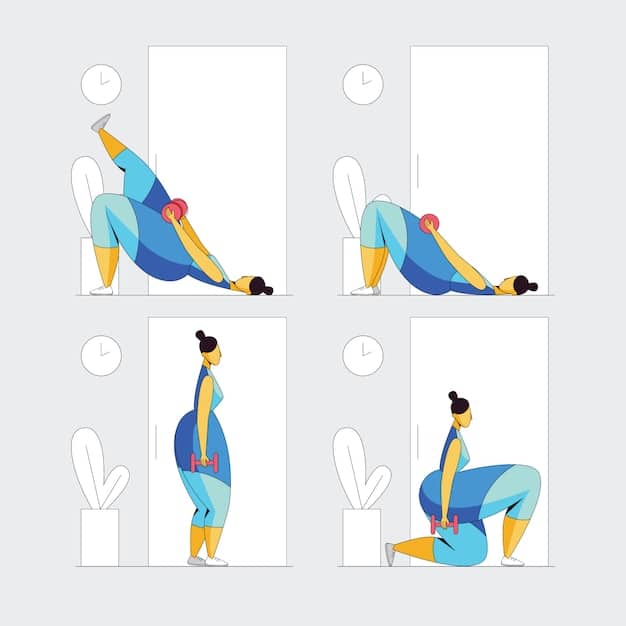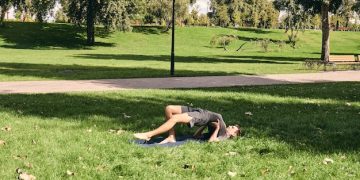Stretching Guide: Improve Flexibility & Reduce Pain with 5 Simple Stretches

The Updated Guide to Stretching: 5 Stretches to Improve Flexibility and Reduce Pain offers a comprehensive approach to enhancing your body’s flexibility and alleviating discomfort, focusing on targeted exercises to promote overall well-being.
Unlock your body’s full potential with The Updated Guide to Stretching: 5 Stretches to Improve Flexibility and Reduce Pain. Discover simple yet effective techniques to enhance your range of motion and say goodbye to unwanted aches.
Understanding the Importance of Stretching
Stretching is often overlooked, but it’s a crucial component of overall health and wellness. It’s not just for athletes; stretching benefits everyone, regardless of age or activity level.
Incorporating regular stretching into your routine can lead to significant improvements in flexibility, reduced muscle tension, and even decreased risk of injury. Let’s explore why stretching is so important.
Benefits of Regular Stretching
Consistent stretching offers a multitude of advantages. These benefits extend beyond just physical improvements, impacting your overall well-being positively.
- Improved Flexibility: Stretching lengthens muscles, allowing for a greater range of motion in your joints.
- Reduced Muscle Soreness: Stretching after exercise can help alleviate muscle tightness and soreness.
- Enhanced Circulation: Stretching increases blood flow to muscles, promoting better nutrient delivery and waste removal.
- Stress Relief: Stretching can help release physical tension, leading to a sense of relaxation and reduced stress levels.
Ignoring stretching can lead to stiffness, pain, and an increased risk of injury. Make stretching a priority to keep your body healthy and functioning optimally.
In conclusion, making stretching a consistent part of your routine can contribute significantly to your physical and mental well-being. Embrace the practice to enjoy a more flexible, relaxed, and pain-free life.
The Science Behind Stretching: How it Works
To truly appreciate the benefits of stretching, it’s helpful to understand the science behind it. Stretching affects your muscles, connective tissues, and nervous system.
When you stretch, you’re not just pulling on a muscle. You’re initiating a complex chain of events that leads to increased flexibility and reduced pain.

Muscle Spindles and the Stretch Reflex
Muscle spindles are sensory receptors within your muscles that detect changes in length. When a muscle is stretched too quickly or forcefully, these spindles trigger the stretch reflex, causing the muscle to contract to protect itself.
This reflex can limit your range of motion and make stretching uncomfortable. However, by stretching slowly and gently, you can override the stretch reflex and gradually increase your flexibility.
Understanding how muscle spindles and the stretch reflex work can help you optimize your stretching technique for maximum benefit.
Ultimately, the science of stretching reveals that it’s a complex process involving your muscles, connective tissues, and nervous system. By understanding this process, you can stretch more effectively and safely.
Essential Stretches for Daily Flexibility
Now, let’s dive into some essential stretches that you can incorporate into your daily routine. These stretches target major muscle groups and can help improve flexibility and reduce pain.
Remember to perform each stretch slowly and gently, holding it for at least 30 seconds. Avoid bouncing or forcing the stretch, as this can increase your risk of injury.
1. Hamstring Stretch
The hamstring stretch targets the muscles in the back of your thigh. Tight hamstrings can contribute to lower back pain and limited mobility. To perform this stretch:
- Lie on your back with one leg extended towards the ceiling.
- Gently pull the leg towards your chest, keeping your knee straight.
- Hold the stretch for 30 seconds, then repeat on the other side.
2. Quadriceps Stretch
The quadriceps stretch targets the muscles in the front of your thigh. Tight quads can contribute to knee pain and poor posture. To perform this stretch:
- Stand tall and grab your foot behind you with one hand.
- Gently pull your heel towards your buttock, feeling a stretch in the front of your thigh.
- Hold the stretch for 30 seconds, then repeat on the other side.
3. Calf Stretch
The calf stretch targets the muscles in the back of your lower leg. Tight calves can contribute to ankle pain and plantar fasciitis. To perform this stretch:
- Stand facing a wall and place your hands on the wall at shoulder height.
- Step one foot back, keeping your heel on the ground and your knee straight.
- Lean forward until you feel a stretch in your calf.
- Hold the stretch for 30 seconds, then repeat on the other side.
4. Hip Flexor Stretch
The hip flexor stretch targets the muscles in the front of your hip. Tight hip flexors can contribute to lower back pain and limited mobility. To perform this stretch:
- Kneel on one knee with the other foot flat on the ground in front of you.
- Gently push your hips forward until you feel a stretch in the front of your hip.
- Hold the stretch for 30 seconds, then repeat on the other side.
5. Shoulder Stretch
The shoulder stretch targets the muscles in your shoulders and upper back. Tight shoulders can contribute to neck pain and headaches. To perform this stretch:
- Reach one arm across your body and gently pull it towards you with your other hand.
- Hold the stretch for 30 seconds, then repeat on the other side.
By incorporating these five essential stretches into your daily routine, you can significantly improve your flexibility, reduce pain, and enhance your overall well-being. Remember to listen to your body and adjust the stretches as needed.
Stretching Techniques for Different Body Parts
While the essential stretches cover major muscle groups, you can tailor your stretching routine to target specific areas of your body that need more attention. Different techniques can be used to address unique needs.
Understanding these targeted techniques can help you optimize your stretching routine for maximum benefit. Let’s explore some specialized stretching methods.

Neck Stretches for Tension Relief
Neck stretches can help relieve tension and stiffness in your neck muscles. These stretches are particularly beneficial for those who spend long hours sitting at a desk or working on a computer.
Gently tilt your head to one side, bringing your ear towards your shoulder. Hold for 30 seconds, then repeat on the other side. You can also gently rotate your head in a circular motion to loosen up your neck muscles.
Back Stretches for Posture Improvement
Back stretches can help improve your posture and reduce lower back pain. These stretches target the muscles in your back and core, promoting better alignment and stability.
Lie on your back and bring your knees towards your chest. Gently rock from side to side to massage your lower back muscles. You can also perform a cat-cow stretch on your hands and knees to improve spinal flexibility.
Arm and Wrist Stretches for Carpal Tunnel Prevention
Arm and wrist stretches can help prevent carpal tunnel syndrome and other repetitive strain injuries. These stretches target the muscles in your forearms and wrists, improving circulation and reducing inflammation.
Extend one arm in front of you and gently bend your wrist downwards, pointing your fingers towards the floor. Use your other hand to gently pull your fingers towards your body. Hold for 30 seconds, then repeat with your wrist bent upwards. You can also perform wrist circles to improve joint mobility.
Customizing your stretching routine to target specific body parts can help address individual needs and maximize the benefits of stretching.
Tips for Safe and Effective Stretching
To get the most out of your stretching routine and avoid injury, it’s important to follow some basic safety guidelines. Stretching should be a comfortable and enjoyable experience, not a painful one.
By following these tips, you can ensure that you’re stretching safely and effectively.
Warm-Up Before Stretching
Warming up your muscles before stretching can help prevent injury. A light warm-up, such as walking or jogging in place, increases blood flow to your muscles and prepares them for stretching.
Stretching cold muscles can increase your risk of strains and tears. A warm-up only needs to last for 5-10 minutes.
Breathe Deeply While Stretching
Breathing deeply while stretching can help relax your muscles and improve circulation. Focus on taking slow, deep breaths, inhaling through your nose and exhaling through your mouth.
Holding your breath can increase muscle tension and limit your range of motion. Deep breathing enhances the relaxation benefits of stretching.
Listen to Your Body
Pay attention to your body’s signals and avoid pushing yourself too hard. Stretching should feel like a gentle pull, not a sharp pain. If you experience any pain, stop the stretch immediately.
- Don’t force a stretch.
- Hold each stretch for at least 30 seconds.
- Stretch regularly for best results.
By following these tips, you can stretch safely and effectively, maximizing the benefits of stretching while minimizing your risk of injury. Always prioritize safety and listen to your body.
The Updated Guide to Stretching: 5 Stretches to Improve Flexibility and Reduce Pain
By understanding the importance of stretching, the science behind it, and following safe and effective techniques, you can unlock your body’s full potential. Regular stretching can lead to improved flexibility, reduced pain, and enhanced overall well-being.
Make The Updated Guide to Stretching: 5 Stretches to Improve Flexibility and Reduce Pain a part of your daily routine and experience the transformative power of stretching! Start slowly, listen to your body, and enjoy the journey to a more flexible and pain-free you. Consider trying other healthy habits, such as proper hydration.
| Key Point | Brief Description |
|---|---|
| 💪 Improved Flexibility | Regular stretching increases range of motion in joints. |
| 🧘 Reduced Muscle Soreness | Stretching reduces tightness and soreness after exercise. |
| 🩸 Enhanced Circulation | Stretching boosts blood flow, aiding nutrient delivery. |
| 😌 Stress Relief | Releases tension, promoting relaxation and reduced stress. |
Frequently Asked Questions (FAQ)
▼
Ideally, you should stretch daily. Even 5-10 minutes of stretching can significantly improve flexibility and reduce muscle tension over time.
▼
Light dynamic stretching is best before a workout to warm up your muscles. Static stretches are more effective after exercise, when muscles naturally relaxed.
▼
Yes, stretching can alleviate the back pain by improving flexibility and reducing tension in back and hip muscles. Specific back stretches provide support.
▼
Hold each static stretch for at least 30 seconds. This allows your muscles to relax and lengthen, maximizing the benefits of the stretch.
▼
Stop the stretch immediately if you feel a sharp pain, as it means you may be overstretching or that you stretched improperly. Consult a healthcare professional.
Conclusion
Embracing the updated guide to stretching not only enhances physical flexibility and reduces pain but also promotes a holistic approach to wellness. Integrating these five key stretches into your daily routine helps optimize muscle function, reduce stiffness, and improve overall quality of life. Consistent practice enables you to build a healthier, more resilient body, well-prepared to meet the demands of everyday life.





